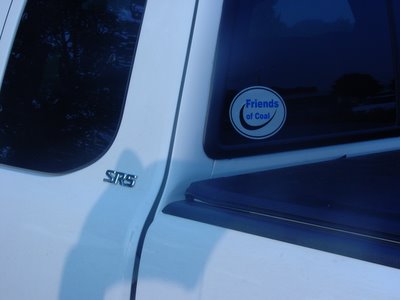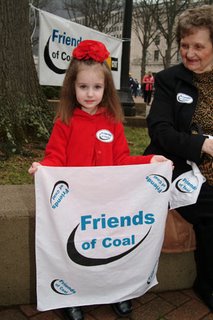
The latest intel from around the triple W and from around your back yard. A collaborative news service where we actually admit that we filter and hand pick what we want you to read, from the concerned folks at Buckeye Sustainability Institute
NOTE: This News section may contain portions of copyrighted material. In accordance with Title 17 U.S.C. Section 107, such attributed material is available without profit to people expressing an interest in this information for research.
5.10.2006
4.20.2006
2.20.2006
1.24.2006
Scenes from the Friends of Coal's latest BASH!
Ohio EPA BUSTS Boyer Signs and Graphics of Cleveland, Ohio
past hazardous waste violations and issued an administrative consent
order on January 13, 2006. The violations occurred at its facility
located at 21611 Tungsten Road, Euclid, Cuyahoga County, Ohio. The
settlement includes a $15,000 penalty of which $12,000 will be deposited
into the state's hazardous waste cleanup fund. In lieu of paying the
remaining $3,000 of the penalty, Boyer Signs & Graphics, Inc., will fund
a supplemental environmental project (SEP) by making a contribution in
the amount of $3,000 to the Ohio EPA Clean Diesel School Bus Program.
You can see the letter the OEPA sent to the bad guys
by clicking here
Ohio EPA BUSTS Accurate Plating Company of Cleveland, Ohio
hazardous waste violations and issued an administrative consent order on
December 19, 2005. The violations occurred at its facility located at
6512 Carnegie Avenue, Cleveland, Cuyahoga County, Ohio. The settlement
includes a $25,000 penalty of which $20,000 will be deposited into the
state's hazardous waste cleanup fund. In lieu of paying the remaining
$5,000 of the penalty, Accurate Plating Company will fund a supplemental
environmental project (SEP) by making a contribution in the amount of
$5,000 to the Ohio EPA Clean Diesel School Bus Program.
You can view the actual letter sent to the polluter by OEPA by clicking
here.
This letter provides you with the actual laws broken (with a regulatory citation) and typically an outline of the situation leading up to the settlement. You would not believe how few of these they send out. Now I understand why other states have privitized this a bit.
1.20.2006
When it pays to buy organic - Consumer Reports article summary
Full text of the CR organic article by clicking the title!
At BSI we try and buy local organic food from reputable sources. The closer the better.
1.09.2006
Pinnacle Gas Producers , LLC BUSTED by the Ohio EPA
You can see the letter the OEPA sent and read the dirty details by clicking here
1.02.2006
Colleges Boycott Coke Over Concerns
Sunday, Jan 01, 2006,Page 11
When students at the University of Michigan return to campus next week after the holiday break, they will find the Coke machines and fountain dispensers empty.
The university, which has 50,000 students on three campuses, on Thursday became the 10th college to stop selling Coca-Cola products because of concerns arising from accusations about the company's treatment of workers in bottling plants in Colombia and environmental problems in India.
A Coke spokeswoman, Kari Bjorhus, said on Friday in a statement that the company hoped the Michigan decision was temporary.
She said Coca-Cola was looking at ways to conduct an independent third-party study of the situation in Colombia.
Labor activists have said that Coca-Cola, through its Latin American bottlers, has been complicit in the deaths of eight union leaders and in continued harassment of unionized employees.
In India, a different group of activists have accused Coke of polluting the soil and groundwater near several bottling plants, of severely reducing groundwater levels in drought-prone areas and of failing to install adequate filtration systems that would remove pesticides from the water used to make its products.
The activists, led by two groups, Corporate Accountability International and the Campaign to Stop Killer Coke, have found a sympathetic ear on college campuses.
Within the last year, New York University, Rutgers University in New Jersey and Santa Clara University in California, among others, have stopped selling Coke products.
The University of Michigan had set yesterday as a deadline for Coke to select an auditor and agree on the terms of the investigation. But talks between the company and the university broke down.
Coke says the accusations about India are groundless.
The company says that its use of water in India has become more efficient and that it has begun harvesting rainwater to help return it to underground sources.
BSI Links to the Source to bring you what Coke has to say.
12.15.2005
Consumption of organic and ethical products on the rise
Full Text available : Drinks Business Review - USA
BSI note: Sammy Smiths has been churning out organic beers in the UK for a while now. This just in, our inside sources in the macrobrewing industry tell us that the country's largest American owned brewer may be positioning itself to launch an organic product in the future as well. I for one cant wait to see the commercials.
While it may be perplexing for some to see the big boys even thinking about brining eco_logical products to the market, consider the tipping point well off in the future and how benificial corporate america err responsable corporate america could be.
I'll drink to that. Now if our local "eco" brewer would even consider an organic product... that would be bOOoooOOmbastic~
12.01.2005
Friends of Coal & Toyota Off Road Team Up?

This image was spotted while traveling recently in southern indiana. 2004 Toyota SR5. prolly 14mpg ay? sends us your favorite gas guzzler shots. We may do something with em.
Wait folks, the fun doesnet just stop with the picture.. oo no :
First, one simply must visit the "Friends of Coal's website
Once you get to know em, you really must party with them!
Sustainability Business Worth $ Trillions
Press Release - United Nations Environment Programme
A powerful alignment of legal, financial, and investment interests will see USD trillions directed in the next decade to evolving markets linked to climate change, clean technology and sustainable use of natural resources, a report being prepared for the United Nations predicts.
"The Working Capital Report", to be published for the first time in March 2006 by the United Nations Environment Programme Finance Initiative, is the culmination of a series of landmark studies undertaken during 2004-5.
This series of UN-backed studies explores the role of financial service companies and capital markets, and the legal context in which they operate, as they capitalise on new opportunities linked to the concept of sustainable development and more effective management of associated risks.
"There is no question that 2005 will be seen as the watershed when the mainstream banking, insurance and investment worlds realised the scale of the commercial opportunities unfolding in the new carbon, clean-tech and sustainable natural resource markets and, also, the legal risks of not being a leader in this area," explained Klaus Toepfer, Executive Director of the United Nations Environment Programme.
Full Text available by clicking here!
SC Johnson, EPA Partner to Design Eco-Products for the Home
GreenBiz.com, 30 November 2005 - SC Johnson has entered into a voluntary partnership with The United States Environmental Protection Agency (EPA) under the agency's Design for the Environment (DfE) Program.
SC Johnson is the first major consumer packaged goods company to partner with EPA on the program, which promotes innovative chemical products, technologies, and practices that benefit human health and the environment.
The wide-ranging partnership recognizes SC Johnson's long-standing commitment to formulate its products with more environmentally preferred ingredients. It also makes provisions for the company to further work with EPA chemists, environmental scientists and risk reduction staff in investigating materials that can further improve the health and environmental profiles of the company's products.
SC Johnson Chairman and CEO Fisk Johnson stated his enthusiasm for the partnership. "We are delighted to continue to partner with the EPA. Design for the Environment supports SC Johnson's commitment to put the environment and human health at the center of product development and formulation. Companies can and should continue to look closely at making investments that are about doing what's right for the business and the environment."
The DfE Program is one of EPA's premier partnership programs, working with individual companies and industry sectors to compare and improve the performance and human health and environmental risks and costs of existing and alternative products, processes and practices. DfE partnership projects promote continuous improvement, integrating more environmentally responsible solutions into everyday business practices.
The Memorandum of Understanding states, "SCJ and DfE are aligned in their ways of assessing and evaluating the potential health and environmental effects of consumer cleaning products, SCJ through its Greenlist process and DfE through its comparative ingredient assessments."
SC Johnson's Greenlist process ensures that the company's products contain materials that are the best available for the environment and consumers without compromising performance, aesthetics, or cost to consumers. The process goes beyond the normal risk assessments and regulatory requirements to evaluate each raw material in every SC Johnson product.
11.27.2005
New S.F. aquarium will be largest 'green' building
10,000 animals, is coming to San Francisco.
On Sept. 14, construction workers broke ground on the new California Academy of Sciences Steinhart Aquarium building, slated to open in Golden Gate Park in late 2008. A key aspect of the $392 million project is its "green" design, which will make the building itself one of the academy's main exhibits.
"San Francisco is the perfect place to do this," said Steinhart Aquarium Director Dr. Christopher Andrews, referring to the culture of environmental concern prevalent in the city. "Much of what the building will speak to is the need for conservation."
The new academy's design, which earned it the Holcim Award for Sustainable Construction, includes solar panels that will provide about 5 percent of the building's power and a "living roof" covered with 1.7 million native plants in six inches of topsoil, which will soak up about half of the rainwater that falls on the building, significantly reducing runoff. The other half will be caught in reservoirs and used as non-potable waste water.
Including the concrete and steel, all of the materials from the old location were recycled, and the academy will use all recycled steel in its new building.
Exhibits at the new California Academy of Sciences Steinhart Aquarium will include old favorites, such as the alligator-inhabited "swamp" near the museum's entrance and the African penguins, as well as several new projects.
"The need for change is key to keep people coming back," Andrews said.
Among the new attractions will be a 90-foot-tall "Rainforest Dome," which will have a living Amazonian rain forest on one side and galleries devoted to rain forests in Borneo, Costa Rica and Madagascar on the other. A three-level walkway will wind its way to the top of the dome, where visitors can board an elevator to a glass tunnel leading through the 100,000-gallon flooded Amazon rain forest tank.
Another icon of the new aquarium will be a 225,000-gallon living coral reef tank. The 20-foot-deep tank will cover
12,000 square feet and feature aquatic life and mangroves from the Philippines. The
living coral reef exhibit will be the first of its size in the United States, an ambitious undertaking that brings new challenges.
"Most of the reef is sustained by light," said aquarium curator Bart Shepherd, who was instrumental in designing the smaller coral reef at the aquarium's current location and is working on the new one. "Our biggest challenge has been providing appropriate light."
Shepherd said the only light bulbs that will work for the new coral reef are not typically found in U.S. aquariums but are the massive halides used to light stadiums.
The Steinhart Aquarium originally opened in Golden Gate Park in 1923 and moved to its temporary location in a former warehouse on Howard Street in 2004. Plans to rebuild the aquarium started in the early 1990s after the cluster of buildings, already showing their wear from age, sustained damages in the 1989 Loma Prieta earthquake. The decision was made to rebuild, rather than renovate, so the new aquarium could be completely redesigned using new technology.
Most of the academy's collection of live animals was moved to the current location in 2004, but some of the animals had to be sent to new homes because of space issues.
Shepherd said the decisions of which large animals to keep were based on size and how easily replacements could be obtained. Large animals that are endangered were kept, while more easily-obtained animals, such as the sharks and alligators, were sent to other aquariums and wildlife preserves.
Even though the new building will feature more than 10,000 animals in its exhibits, the California Academy of Sciences Steinhart Aquarium plans to keep its personal approach to help educate visitors, with staff members and volunteers ready to explain exhibits to museum-goers.
"If you want to provide information, and effect change, the most important aspect is people to people," Andrews said.
>> Special thanks to at Shea Gunther for this most excellent story... we read it at his blog first! Given our interest in the guest services industry (read: hotels, resorts, ski resorts, and amusement parks, etc)
11.04.2005
Parents going organic
By Associated Press | November 3, 2005
WASHINGTON -- Erin O'Neal has two daughters and a fridge stocked with organic cheese, milk, fruits, and vegetables in her Annapolis, Md., home.
Article Tools
She is among the increasing number of parents who buy organic to keep kids' diets free of food grown with pesticides, hormones, antibiotics, or genetic engineering. ''The pesticide issue just scares me -- it wigs me out to think about the amount of chemicals that might be going into my kid," said O'Neal, 36.
Sales of organic baby food have jumped nearly 18 percent since last year -- double the overall growth of organic food sales, according to the marketing information company ACNielsen.
As demand has risen, organic food for children has been popping up outside natural food stores. For example, Earth's Best baby food, a mainstay in Whole Foods and Wild Oats markets, just reached a national distribution deal with Toys ''R" Us and Babies ''R" Us. Gerber is selling organic baby food under its Tender Harvest label. Stonyfield Farm's YoBaby yogurt can be found in supermarkets across the nation.
The concern about children is that they are more vulnerable to toxins, said Alan Greene, a California pediatrician. As children grow rapidly, their brains and organs are forming and they eat more for their size than do grown-ups, Greene said. ''Pound for pound, they get higher concentrations of pesticides than adults do."
New government-funded research adds to the concern. A study of children whose diets were changed to organic found their pesticide levels plunged almost immediately. The amount of pesticide detected in the children remained imperceptible until they were switched back to conventional food.
''We didn't expect that to drop in such dramatic fashion," said Emory University's Chensheng Lu, who led the research.
© Copyright 2005 Globe Newspaper Company.
10.22.2005
Just How Much is the Stuff of Teflon® Sticking It to Us? Are Fluorinated Compounds the New Chlorinated Compounds?
From Teflon pans to Stainmaster carpets, non-stick materials have become such an integral part of American homes, that they’re now part of our vernacular. Ronald Reagan was christened the Teflon president because controversy seemed to bounce right off his administration while reputed gangster John Gotti was called the Teflon Don because prosecutors could never get their charges to stick.
From Scotchgard to Silverstone, today’s non-stick materials are based on a class of compounds called perfluorochemicals, or PFCs. PFCs share some unique properties that make them extremely useful. Resistant to chemicals and heat, virtually nothing sticks to or can be absorbed by PFCs or products made from them. These attributes make them ideal coatings for cookware, upholstery, food packaging, appliances, clothing, and many other kinds of products. PFCs are also used in things like floor wax and shampoos because they have an innate ability to repel grease and oils.
The PFC family of chemicals consists of a variety of different substances. Chief among these is a compound called perfluorooctanoic acid, or PFOA. PFOA is a key building block of many non-stick products. It also is created when other types of PFCs break down during use.
Full Text Here!!
ps - some at BSI are phasing out t-fal pots and pans in favor of their great grandmothers cast iron skillets handed down over the generations. others are using fluropolyers all the live long day. Choose your own adventure!
10.12.2005
Indiana burg to become "BioTown"
The small farming community of Reynolds, Ind., is gearing up to take advantage of its ripest renewable resource: vast amounts of stinky hog poop. Gov. Mitch Daniels (R) and the Indiana Department of Agriculture have designated the one-traffic-light burg as the world's first "BioTown." The plan is for its homes and businesses to run on electricity generated by the burning of methane released from hog waste. "The goal is to create a new use for the manure that's surrounding the town -- as a biofuel," says Deborah Abbott of the state Ag Department. Methane from the town sewer may eventually be tapped as well.! Officials also want to get all the vehicles in town running on fuel with a high percentage of corn-derived ethanol or soy-derived biodiesel. "We're very excited," said Charlie Van Voorst, president of the Reynolds Town Board. "They're advertising us as a showcase for the world."
The Indianapolis Star, J. K. Wall, 13 Sep 2005 ,
Planet Ark, Reuters, 13 Sep 2005
10.10.2005
Ohio Advocates Seek Constitutional Amendment
CINCINNATI--Ohio landfills accepting construction and demolition debris
would have to follow the same environmental guidelines as other landfills
under a ballot initiative proposed by a citizen group.
The group, called R Lives Count Too, filed language for a constitutional
amendment Sept. 28 with the attorney general's office, the first step in
placing an issue on the state ballot.
The group hopes to get the landfill initiative, which would require waste
from man-made structures to be regulated the same as solid waste, before
voters in November 2006.
According to the group, state regulations governing construction and
demolition landfills are less stringent than those for other landfills,
and legislative attempts to remedy the problem have failed.
There are 69 construction and demolition debris landfills licensed to
operate in Ohio.
Construction wastes such as lead pipes, drywall, and asbestos pose a
significant threat to air, soil, and water quality, according to Debbie
Roth, president of Our Lives Count Inc. in Leavittsburg.
When drywall materials sit in a wet landfill, Roth said, hydrogen sulfide
is created and escapes into the environment. Despite the toxic threat,
these construction landfills do not have to meet the same standards as
solid waste landfills, she said.
Ohio Finds Unsafe Levels of Toxic Chemicals
An Ohio Environmental Protection Agency analysis of leachate from nine
construction and demolition debris landfills, released Sept. 27 through
the Ohio Environmental Council, found concentrations of toxic chemicals
exceeding safe drinking water standards.
Average concentration levels for several hazardous substances were much
higher than normal background levels in Ohio groundwater, the agency
found, noting arsenic at 36 times the average background level and cadmium
at 61 times the average background level.
The analysis was done for the Ohio General Assembly's Construction
Demolition Debris Study Council, which is examining ways to strengthen the
state's regulations governing these landfills.
Under current state law, construction and demolition debris may be placed
in landfills without protective liners and with minimal leachate
monitoring.
State officials have told lawmakers that construction and demolition
debris landfills are a growing problem in Ohio due in part to hydrogen
sulfide production, improper handling of asbestos materials, and the
acceptance of unrecognizable waste, most of which comes from out-of-state.
Construction Industry Opposes Regulations
Construction industry representatives told the legislative panel that this
type of waste is inert and that there is no scientific justification for
more stringent regulation.
Rep. John P. Hagan (R), a member of the landfill study council who plans
to sponsor a bill revising the state's applicable regulations, said the
ballot issue would not affect legislation being developed.
If the attorney general certifies the proposed amendment's language, the
Ohio secretary of state will verify whether the group can begin a petition
campaign. To get the issue on the ballot, R Lives Count Too will need to
collect 322,000 signatures by next August.
More information on the ballot initiative is available at
http://www.OurLivesCount.org.
The Ohio EPA analysis is available at
http://www.theoec.org/hottopics_pressroom.html.
9.22.2005
Canon invests in organic flat panel displays
By Nick Farrell: Wednesday 21 September 2005, 16:04
JAPANESE COMPANY Canon said that it will spend more than ¥500 billion (~£2.48 billion) researching new organic flat-panel display screens and rear-projection televisions.
Previously Canon announced it was going to spend ¥300 billion yen (£1.4 billion).
The main area of research will be electro-luminescent displays, which sandwiches a very thin layer of organic material between two plates. These , use less power and offer brighter images and wider viewing angles than liquid crystal display panels.
Canon wants to have a commercial launch of the new display panels by 2007 and sees demand of around 20 million units a year.
It is also looking at a joint development with Toshiba of surface-conduction electron-emitter display panels, which are due to hit the market in early 2006.
>>>BSI likes to think one is cautious in assuming the term 'organic' always conveys wholesome goodness. Think persistant organic pollutants. ;-)
9.19.2005
INHOFE INTRODUCES LEGISLATION TO ALLOW EPA TO WAIVE ENVIRO LAWS
Public Works Committee, introduces legislation that would
allow EPA to waive environmental laws and regulations for up
to 18 months if the agency determines that is necessary to
respond to Hurricane Katrina. The legislation (S. 1711)
comes as EPA says it may need additional legal authority to
facilitate cleanup and restoration, although environmental
advocates criticize the legislation as an "open invitation"
for business interests to pressure EPA into granting
waivers. The legislation would give EPA authority to waive
any law or regulation it administers for 120 days. The
agency would be able to extend that waiver for up to 18
months if the administrator deems it appropriate.
9.18.2005
Nature may offer vital clues on rebuilding New Orleans
Wednesday, September 14, 2005
When Katrina's winds flattened Gulf Coast homes and businesses, biologist Janine Benyus looked to the trees for clues on how to rebuild.
"Under a forest, you have as much biomass as you have on top -- there are root systems grafted to other root systems," Benyus said at San Francisco's Palace Hotel last week. "So when the wind blows, ... notice how many trees stood among buildings that fell. When we go back to build, we have to ask those trees: How are you still standing?"
It's all about "Biomimicry" for Benyus, who in 1997 wrote the so-titled book on the maverick science of appropriating the best ideas of nature to solve problems and improve conditions for humans.
Thursday, at the International Interior Design Association's Leader's Breakfast honoring architect Richard Hannum, Benyus connected some recent findings and current projects in her field to the design, architecture and building tasks of her listeners.
Bird feathers show a Georgia carpet tilemaker how to put together a seamless product low on adhesives so that health care facilities will want it. Trees combing moisture from fog prompt a scientist in England to find a way to extract potable water from humid air. A kingfisher's beak inspires engineers in Japan to construct a quieter bullet train.
"We're surrounded by genius," Benyus told them. "These other organisms are elders compared to us. We are a very young species. ... Three-point-eight billion years is a very long time to do R&D."
Benyus ventured that "our interiors will tell us when there are contaminants in the air." Canes with eco-location inspired by bats will guide the blind; jewel beetles, which "can smell and feel a fire 50 miles away," will lead us to new smoke detectors; the lobster's ability to sense chemical plumes in a molecule of water will translate into a way to make sure we're not drinking sludge.
Studies on how butterflies and peacocks display brilliant colors yet contain no pigment except brown are paving the way to chemical-free hues. Work by Jay Harman, with Pax Scientific in San Rafael, has answered the question "How would a nautilus make a better fan?" with spiral-based air handlers that save energy and are quieter than electric fans.
The "lotus effect," where rainwater does the cleaning, could revolutionize car paints, roofing and even our household cleaning products -- a prospect that Benyus said didn't go over too well when she shared it with an Amway convention.
The lotus effect also has led to the development of a formaldehyde-free plywood that, according to Benyus, is "very cheap" and is being tested by Columbia Forest.
Benyus urged listeners to create "designs that are conducive to life" and promised them free access to a database of natural design solutions that is being tested by the Biomimicry Guild at database.biomimicry.org.
More information about "biomimicry" is accessible online at www.biomimicry.net.
9.09.2005
CHANGES MADE TO EPA COMPUTER MODEL FOR CALCULATING CIVIL PENALTIES
calculating civil penalties, but the agency delays issuance
of guidance for determining a company's economic gain due to
an "illegal competitive advantage" from noncompliance. The
revised BEN model, the software used to determine a
violator's benefit from avoiding pollution control
expenditures, is more user-friendly and will allow more
precise calculations than the previous version.
INDUSTRY ASKS CONGRESS FOR NATIONAL POLICY ON RECYCLING
Commerce Subcommittee on Environment and Hazardous Materials
that federal involvement is needed to develop a national
policy on the recycling of waste electronics and to avert a
"patchwork" of state regulations, but they remain divided on
how to pay for it. Witnesses testifying before the
subcommittee propose a range of approaches, such as an
advance recycling fee added to the retail price of a product
or the addition of internal costs to be absorbed by
manufacturers. Lawmakers are now considering various
approaches to deal with the nation's growing stream of old,
discarded electronic products. They could wait to review the
results of differing laws in California, which mandates a
consumer-based advance recycling fee, and Maine, which
promotes manufacturer responsibility, according to Rep.
Gillmor, the subcommittee chairman.
8.06.2005
Recycled Paper Accounts for Two-Thirds of Office Depot's 2004 U.S. Paper Sales

Source: GreenBiz.com
DELRAY BEACH, Fla., July 12, 2005 - Office Depot has announced that 65% of its 2004 U.S. paper sales came from recycled paper -- a 373% increase from 2003.
Office Depot, who last year became the first company in the office products industry to set annual quantified environmental performance objectives, also reported that the average annual post-consumer waste (PCW) recycled content of all paper it sold in the United States last year climbed by nearly 125%.
During 2004, 65.3% of Office Depot's total U.S. retail, contract business, and commercial paper sales contained PCW recycled content -- up from 13.8% in 2003. In addition, the overall average PCW recycled content (total weight of recycled fiber as a percent of total paper weight) of paper sold across all U.S. channels reached 10.5% -- up from 4.5% in 2003.
"We are thrilled to report that nearly two of every three sheets of paper sold in the United States by Office Depot last year contained recycled content," said Tyler Elm, director of environmental affairs for Office Depot. "With paper being the most ubiquitous single office product, [this] sales effect [is] ... a testament to the growing public and corporate adoption of our quality recycled paper."





